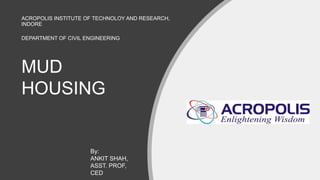This document discusses various mud construction techniques that have been used for thousands of years. It begins by explaining that mud has been one of the most essential building materials since early humans and that approximately 58% of buildings in India are made of mud bricks. It then provides details on different mud construction methods like stacked earth (COB), rammed earth, adobe, wattle and daub, formed earth (straw clay), earth filled in, compressed earth blocks, extruded earth, and cut earth. For each method, it describes the materials and construction process. It also discusses mud roofs and provides advantages and disadvantages of mud construction.





























